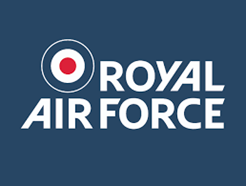When the project to build Tornado got underway the first Gulf War was also taking place. It was the involvement of the iconic aircraft of the same name that gave the idea to name the new A1 Tornado. This affiliation has gained strength over the years, from force development events and dining trains with RAF Marham to gaining volunteers from the RAF community. The RAF was soon keen to support and in January 1995 a long and fruitful Affiliation with the service commenced.

To commemorate the completion of the locomotive’s frames at Tyseley Group Captain ‘Raz’ Ball, Station Commander, RAF Cottesmore handed over to the Trust Tornado’s two nameplates – one with the badge of RAF Cottesmore and the other with the badge of the Tri-national Tornado Training establishment based there – both painted by groundcrews at the RAF station. He commented,
“I was delighted to be invited to become involved with the Project, particularly as the locomotive will perpetuate the name of an aircraft and its crews which have become and will remain the backbone of Europe’s support for NATO well into the next century. More than any other station, RAF Cottesmore can claim to be the home of the Tornado, as aircrews of the Royal Air Force, the German Air Force, the German Navy and the Italian Air Force have been converted to the Tornado GR1 here since 1981 when the aircraft first entered service with the three nations.”

Correspondence and updates followed throughout the construction period of Tornado and when the planning for the naming ceremony got underway it was obvious a flypast would add to the day. The RAF not only achieved a spectacular three jet flypast, the artisans at RAF Leeming also gave the nameplates a freshen up before they were fitted to the locomotive. It was at this point the locomotive’s plates when applied showed the RAF Leeming badge on the driver’s side and the RAF Cottesmore badge on the fireman’s side.
Further communications came about as the locomotive hauled trains across the country and included visits by A1SLT volunteers to RAF Marham to see the Tornado GR4 jet up close, and for RAF Marham personnel to have a chance to get up close to our own slightly lower and slower Tornado. After a variety of joint activities, it was clear that RAF Marham would become the last base for Tornados and, in a ceremony at the Nene Valley Railway, the badge on the fireman’s side was changed for that of RAF Marham.

As the date approached when the Tornado would retire from the RAF, a fitting tribute to aircraft and locomotive was developed to get both the jet and the locomotive together. The opportunity came on the Wensleydale Railway when, as part of a national farewell tour, three Tornados flew over Tornado as they lined up for a pass of the runway at RAF Leeming.

Whilst the Tornado jet is no longer flying with the RAF the Trust continues to maintain its strong affiliation with the RAF with events to deepen this relationship.. This has included a special train to London for RAF families in 2018 as part of the centenary of the RAF, a commemorative 25-year affiliation anniversary dinner, refurbishment of the nameplates once again and help with training opportunities and the introduction to the benefits of digital technology at the RAFs innovation hub. The RAF is at the cutting edge of this development and the Trust is now examining the use of Augmented Reality tech to aid maintenance and repair.
Other initiatives are also planned, especially with RAF Leeming and RAF Marham. The latter is now home to the famous 617 ‘Dambusters’ Squadron, flying the new F35 Lightning 2 jets, deployed aboard HMS Prince of Wales, providing a further connection across both of our locomotives and their respective associations.
